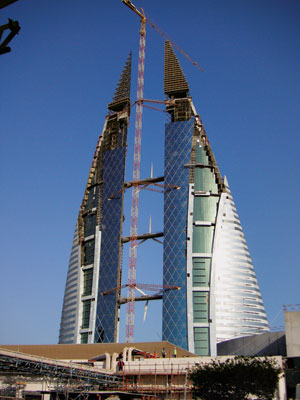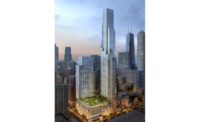A deep understanding of wind behavior gained from 25 years of sailing prepared architect Shaun Killa to successfully promote the largest-ever integration of electricity generating turbines into a building, the Bahrain Word Trade Centre.

The three 275-kW turbines were commissioned last April, and are due to start meeting 15% to 25% of the tenants energy demand as they move in over the next months. The undisclosed developer grabbed the chance of owning the uniquely energized, 240-meter-tall twin towers offered by its architect, says South Africa-born Killa. He heads the 150-person architecture unit of Atkins Middle East Ltd., Dubai, which handled the project’s total design.
“In plan and elevation, the building has been sculpted by the wind,” says Killa. With elliptical floor plans, the towers are linked by three bridges spanning over 30 m with a 29-m-dia wind turbine at their centers.
The towers are orientated to funnel wind into the turbines, raising its speed. Shaped like aerofoils, the towers create negative pressure on the leeward side, accelerating the wind even further.

Twin towers are “sculpted by the wind,” funneling wind into the turbines. Vibration problems were cured with rubber bearings.
Tapering as they rise, the towers reduce this funnel effect, countering the increasing wind speeds with height, and making conditions around the turbines roughly the same.
“This has never been done before, so I had to find somebody to help us,” says Killa. Several months of searching led to a Danish team of the design firm Rambøll Denmark A/S and turbine manufacturer Norwin A/S engineering the three bridge/turbine assemblies.
Rambøll and Atkins’ global engineering team identified and resolved numerous potential technical problems, says Killa. Among the most serious was vibration, cured by inserting rubber bearings at the bridges’ ends. Costing 3% of the building’s undisclosed total, the generating system has a payback period that could be as little as 2.5 years, hopes Killa. If Bahrain’s embargo on exporting to the grid persists, surplus power generated by the turbines in non-working hours may produce chilled water instead, he says.
Bahrain World Trade Centre has triggered a local debate about alternative energy, demonstrating that turbines are neither dangerous nor noisy, believes Lars Thorbek, Rambøll’s project manager. The turbines also enhance the buildings’ prestige, adds Blair Hagkull, managing director of leasing agent Jones Lang LaSalle MENA, which is not involved in the project. “In a region of iconic development, the [building] has achieved what all others have strived for: distinctive architecture with truly sustainable features,” he says.



Post a comment to this article
Report Abusive Comment